Thai food is well-known for its bold flavors, rich taste, and distinctive aroma. Behind this deliciousness lies one essential element—curry paste, or what Thai people call “krueng gaeng.” Curry paste is the heart of many Thai dishes. It’s a blend of herbs, spices, and fragrant ingredients that are pounded or ground together to create the foundational flavor of countless Thai recipes.
At Sriphai Thai Kitchen, we believe in teaching Thai cuisine in a simple and friendly way, so everyone can cook it at home and understand the deeper cultural meaning behind every dish. In this article, we explore 7 essential Thai curry pastes that form the soul of many classic Thai meals.
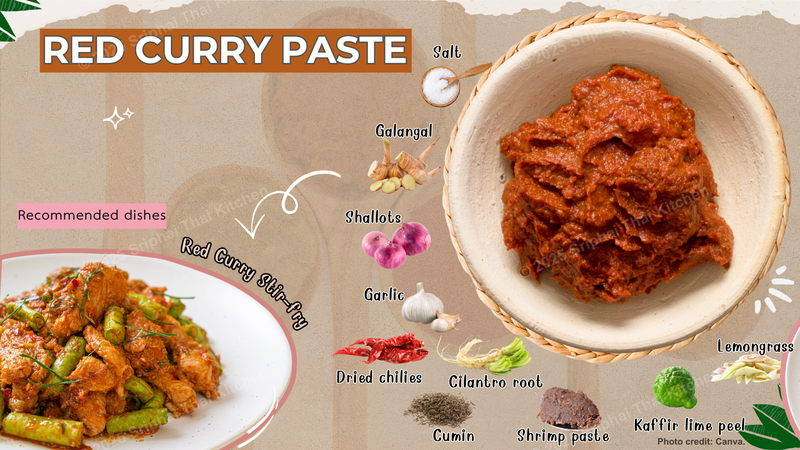
1. Red Curry Paste
Flavor Profile: Spicy, aromatic, and balanced with a hint of sweetness.
Ingredients: Dried red chilies, lemongrass, galangal, garlic, shallots, kaffir lime zest, coriander root, cumin seeds, shrimp paste, and salt.
Common Dishes: Gaeng Daeng (Red Curry with Chicken), Red Curry with Duck, Thai Red Curry Stir-fry
Red curry paste is one of the most versatile curry pastes in Thai cuisine. It's deep red color comes from dried red chilies, and it's perfect for coconut milk-based curries. You can use it with meat, seafood, or tofu. If you’re just starting out, this is a great paste to begin experimenting with.
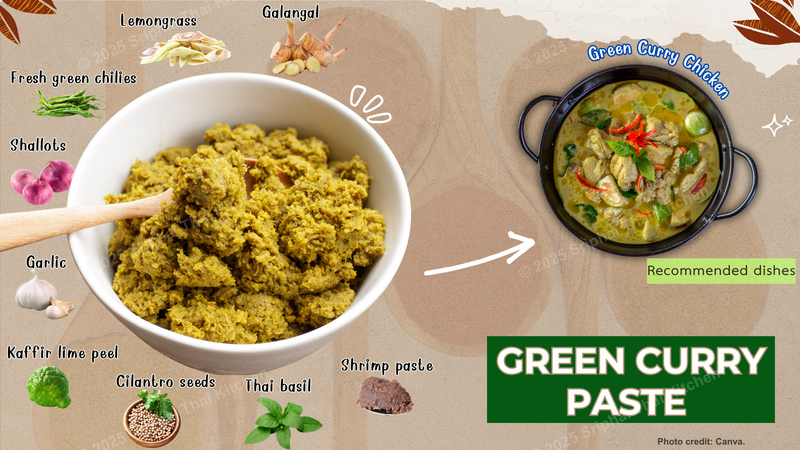
2. Green Curry Paste
Flavor Profile: Spicy, slightly sweet, and very fragrant.
Ingredients: Fresh green chilies, lemongrass, galangal, garlic, shallots, kaffir lime peel, coriander seeds, shrimp paste, and Thai basil.
Common Dishes: Gaeng Keow Wan Gai (Green Curry Chicken), Green Curry with Fish Balls, Vegetarian Green Curry
Green curry paste is known for its bright color and bold flavor. It’s typically spicier than red curry and goes well with coconut milk. Fresh green chilies are key to its vibrant color and kick. It’s a favorite among Thai people and often enjoyed with steamed rice or thin rice noodles.

3. Yellow Curry Paste
Flavor Profile: Mild, earthy, and slightly sweet with warm spices.
Ingredients: Dried chilies, turmeric, curry powder, cumin, coriander, cinnamon, garlic, lemongrass, and shallots.
Common Dishes: Stir-fried Crab with Yellow Curry Paste and Stir-fried Squid with Yellow Curry Paste
This curry paste is often influenced by Indian and Persian flavors. It’s great for those who prefer a milder heat. The turmeric gives it a warm yellow hue and earthy flavor, perfect for creamy curries with potatoes, carrots, and onions.
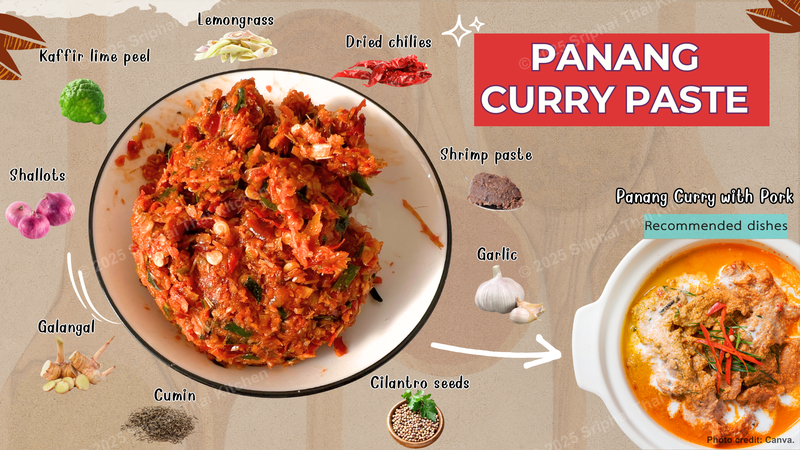
4. Panang Curry Paste
Flavor Profile: Rich, nutty, slightly sweet, and less spicy.
Ingredients: Dried red chilies, lemongrass, galangal, garlic, shallots, kaffir lime peel, coriander, cumin, peanuts, and shrimp paste.
Common Dishes: Panang Curry with Beef, Panang Curry with Pork or Chicken
Panang curry paste is rich with Thai herbs and spices. It’s mildly spicy, creamy, and aromatic when simmered with coconut milk.
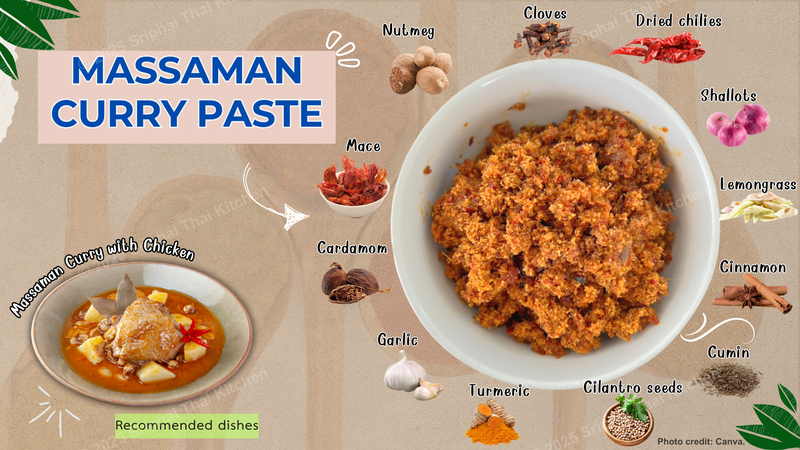
5. Massaman Curry Paste
Flavor Profile: Mild, sweet, aromatic, and full of warm spices.
Ingredients: Dried red chilies, cinnamon, cardamom, cloves, cumin, coriander, nutmeg, mace, garlic, shallots, galangal, lemongrass, and shrimp paste.
Common Dishes: Massaman Curry with Beef, Lamb or Chicken, Massaman Curry with Tofu
This curry is influenced by Persian and Indian cuisines and is especially popular in southern Thailand. Its deep, complex flavor comes from dry spices that are not typically used in other Thai curries. It’s often cooked slowly with meat and potatoes.
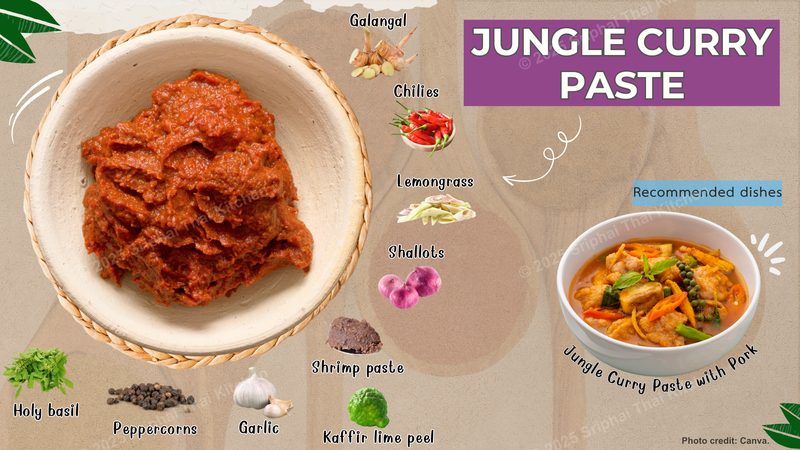
6. Jungle Curry Paste
Flavor Profile: Spicy, earthy, herbaceous, and no coconut milk.
Ingredients: Fresh red or green chilies, garlic, galangal, shallots, lemongrass, kaffir lime leaves, holy basil, peppercorns, and shrimp paste.
Common Dishes: Jungle Curry Paste with Pork, Chicken, or Fish
Unlike most Thai curries, Jungle Curry doesn’t use coconut milk. It’s lighter, very spicy, and filled with vegetables and herbs. It originated in forested regions of Thailand, hence the name. It's perfect if you want to try a more traditional, fiery dish.
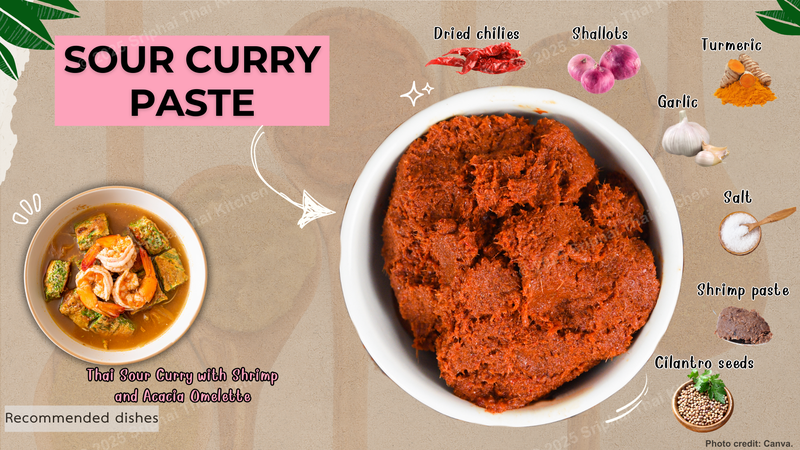
7. Sour Curry Paste
Flavor Profile: Sour, salty, tangy, and no coconut milk.
Ingredients: Dried red chilies, shallots, garlic, fermented shrimp paste, salt, and sometimes turmeric.
Common Dishes: Sour Curry with Fish and Vegetables and Thai Sour Curry with Shrimp and Acacia Omelette
Sour curry is a water-based curry popular in southern and central Thailand. The unique flavor comes from tamarind, which gives it a tangy sourness that pairs well with seafood and vegetables. It's a great option if you want something light but flavorful.
👩🍳 Tips from Sriphai Thai Kitchen:
1.If you have time, try making your own curry paste at home—it’s so much fresher and more flavorful!
2.You can store homemade curry paste in the fridge for up to one week, or freeze it in small portions for convenient use later.
At Sriphai Thai Kitchen, we offer easy-to-follow how-to articles on authentic Thai cooking, along with professional tips to help you cook Thai food like a chef—all while learning about Thai culture through your favorite dishes.
📖 Download our free e-magazine filled with must-try Thai recipes, easy cooking techniques, and stories about the mission of Avoda Foundation. Sriphai Thai Kitchen proudly supports the foundation's work in Thailand, helping children and local communities in need.
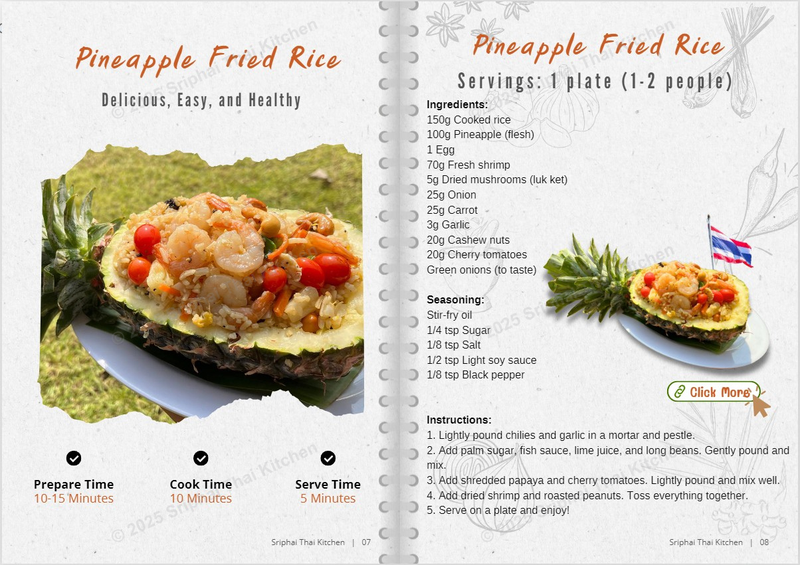
📥 Download the free e-magazine here! Free E-magazine | Sriphai Thai Kitchen
Join me on YouTube at: Sriphai Thai Kitchen
What’s your favorite Thai curry? Let us know!
And don’t forget to follow Sriphai Thai Kitchen for more stories and recipes that will make you fall in love with Thai food even more every day 💚
Comments